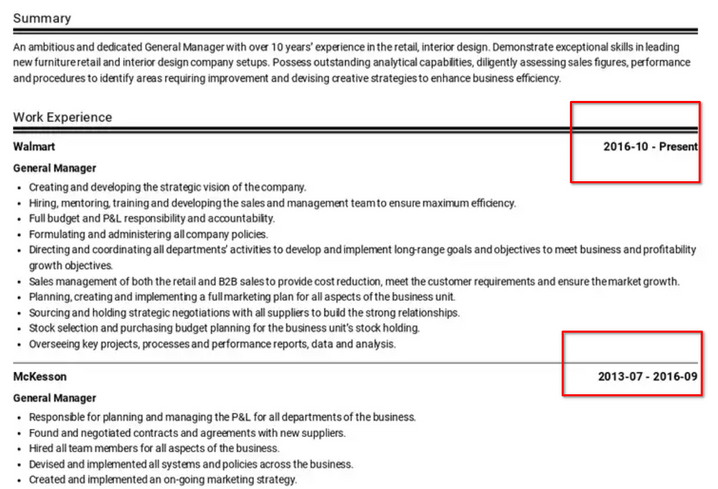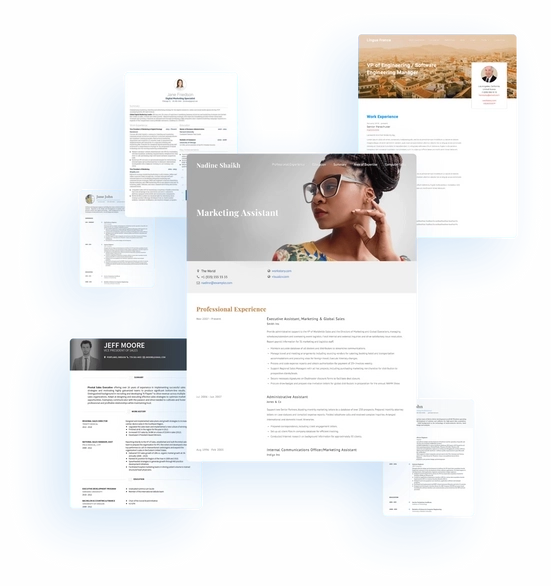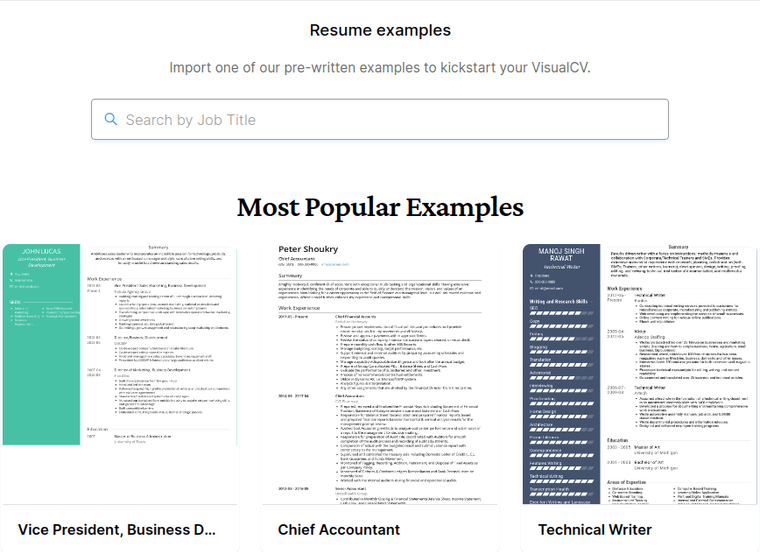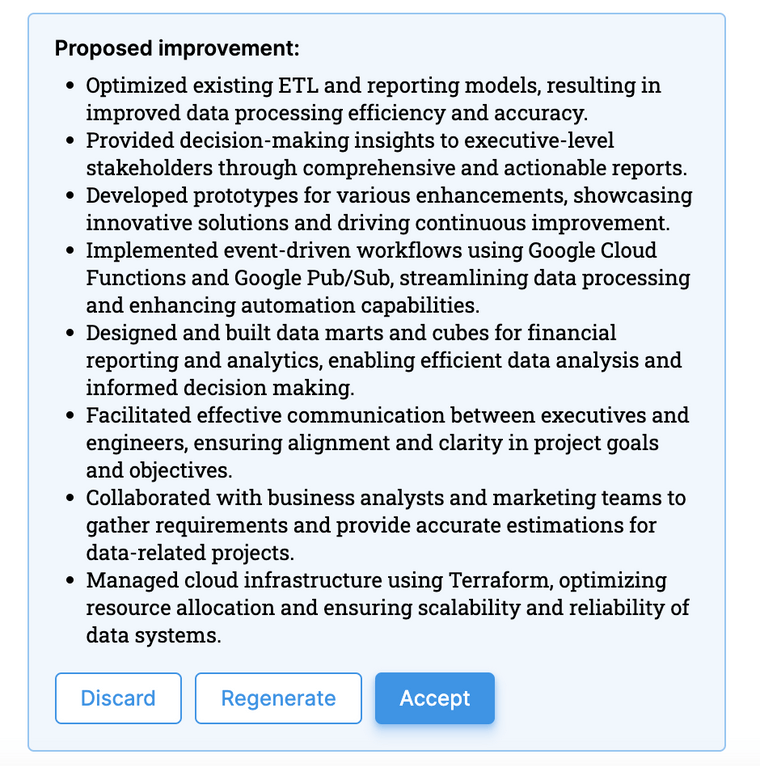
Dates on Resume: Templates, Format, Aligning, and More Tips

When potential employers looks at a resume, they scan where you work, how long you worked there, and what you did there, among other things. For job seekers, presenting this information clearly is crucial to making a strong impression.
If you are here, you want to better understand how to list dates on your resume. After all, it is one of the critical aspects that hiring managers scan for.
Best resume date format, the length of dates on resume, what dates to include on a resume, and where to add dates on your resume - we will be diving deep into these questions to help you add dates on resume in the best way possible.

Why List Date on a Resume?
Dates are important and should be added to the resume because:
- Dates on your resume helps recruiters understand your total work experience.
- Dates on resume help recruiters understand how long you work for an organization.
- Dates on resume helps recruiters understand your relevant work experience in years or months.
- Dates on resume help recruiters understand when you graduated or took a certification.
Date Format on Resume?
To do your dates right, you should first look at different date formats that exist to list. There are a few different formats that you should use:
- Right aligned date formats - where your dates are on the right side of the resume.
- Left aligned date formats - where your dates are on the left side of the resume.
- Left aligned, below the job title/degree.
These date formats for resumes are then further divided into:
- Start year - End of year (e.g 2020-2021)
- Start Month, Year - End Month, Year (e.g June, 2020 - June, 2021)
- Start Day, Month, Year - End Day, Month, Year (e.g 1st June, 2020 - 1st June, 2021)
- Month, Year (e.g. June, 2020)
We will also provide you with templates for dates on resume, ensuring they are in reverse chronological order for clarity and impact.
Where to Add Dates on Resume?
You can add dates in the following sections of your resume:
- Your resume’s certification section.
- Your resume’s work experience section.
- Your resume’s education section.
- Your resume’s awards section.
- Your volunteer positions.
- Your state/nationa/international presentations.
- Your speaking engagements.
Let’s take a look at each of these with a bit more depth.

Add Date to Your Resume’s Work History
You can’t get this one wrong. You should put your start date and end dates for each job title on your resume's work history.
Almost every recruiter would want to understand how long you worked. Dates on work history allow them to see what you did/achieved during that time.

Dates on your resume also allow them to total the duration of your work under a specific job title.
Work Experience - Left Aligned Date Format for Resume Template
[Company name], [Start month, year - End month, year] [City, State] [Job title} [Job description]
Work Experience - Right Aligned Date Format for Resume Template
[Company name] [Start month, year - End month, year] [City, State] [Job title] [Job description]
Work Experience with Date Below Job title - Template for Dates on Resume
[Company name] [Start month, year - End month, year] [City, State] [Job title] [Job description]
Work Experience with No Month Date Format on Resume
[Company name], [Start year - End year] [City, State] [Job title] [Job description]
When you add a date range on your resume's work experience section—especially for roles lasting over five years—using years instead of months can suffice (e.g., 2020-2021). Whenever possible, we recommend adding months.
Add Date to Your Resume’s Certification Section
When you put a date to your certifications - that makes it easy for a recruiter to see whether you are certified or not, how long you have been certified, and when your certification would expire.
Also, think about a contractor that has to be certified - a valid certification prioritizes someone applying for a contractor role over someone who doesn’t have a valid certification.
You can use these templates provided below to put dates on your resume’s certification.
Certification Template for Dates on Resume - Month, Year
[Name of the certification], [Certification number] - [Start Month, Year]
Certification Template for Dates on Resume - Month, Year With Validity
[Name of the certification], [Certification number]: [Start Month, Year]-[End Month, Year]
Certification Templates for Dates on Resume When Month is Not Important
[Name of the certification], [Certification number]: [Start Year]-[End Year] [Name of the certification], [Certification number]: [Start Year]
Certification With no Expiry Templates for Dates on Resume
[Name of the certification], [Certification number]: [Start Year] [Name of the certification], [Certification number]: [Start Month, Year]
Add Date to Your Resume’s Education Section
When you put your graduation date in your resume's education section, you help an employer by:
- Understanding when you graduated from college.
- Making it easier to explain a career gap due to education.
- When you are expected to graduate from college.
- Displaying you are an entry-level candidate with skills, but no experience.
That's why we recommend that you add graduation dates to your education history on your resume. There are a few templates that you can use to put dates on your resume's education section below.
Recent Graduate Template to Put Dates on Resume
[Degree] [GPA] [Start Month, Year - End Month, Year]
Less Than 5 Years Exp - Template to Put Dates on Resume
[Degree] [Start Year - End Year]
Ongoing Education Template to Put Dates on Resume
[Degree] [GPA] [Start Month, Year - Expected Completion Date]
Add Date to Awards You Received on Your Resume
Adding dates to awards is considered valuable to your resume.
While you may not think much about it, an employer will try to see if they can find what you were awarded for.
An employer searching for what award you received is the impact you would like to leave on an employer.
The date formats below will show you how to add dates to your awards on resume, including using a single date format where applicable.
Awards Template to Put Date on Resume With No Month
[Award name] [Year]
Awards Template to Put Date on Resume with Month and Year
[Award name] [Month, Year]
One thing to consider while listing your award dates on your resume is whether an award is a yearly award or a monthly/quarterly award:
- Date considerations for yearly awards - listing the year alone should be sufficient.
- Date considerations for monthly or quarterly awards - consider listing the month and year together to give the full context.
Adding Dates to Volunteer Positions on Resume
Listing volunteer positions on resume can create confusion if they are listed without dates on resume.
We spoke to a number of HR recruiters around it and the top sources of confusion were highlighted in form of these questions:
- Is this person still a volunteer for this organization?
- Is this person a {volunteer} title?
Now, as you can see, both of these can be solved by simply adding a date to volunteer position(s).
You can date formats similar to how you would put them in your work history section. We would recommend that you keep them consistent.
Single Date Format for Awards on Resume
When listing awards on your resume, a single date format is often the best choice. This format emphasizes the year you received the award without cluttering your resume with unnecessary details.
Why Use a Single Date Format for Awards?
- Clarity: A single date format clearly indicates when the award was received, making it easy for potential employers to understand your achievements.
- Simplicity: It helps maintain a clean and concise resume, focusing attention on your accomplishments.
- Relevance: For awards that are granted annually or do not require detailed duration, a single year is sufficient.
Examples of Single Date Format for Awards:
-
Award Template: Award Name - Year Example: Employee of the Year - 2022
-
Monthly or Quarterly Awards: If necessary, you can add the month for more context: Example: Top Salesperson of the Month - March 2022
Using a single date format for awards keeps your resume polished and professional while effectively showcasing your achievements.
Volunteer Position - Left Aligned Date Format for Resume Template
[Company name], [Start month, year - End month, year] [City, State] [Volunteer Position] [Volunteer work description]
Volunteer Position - Right Aligned Date Format for Resume Template
[Company name] [Start month, year - End month, year] [City, State] [Volunteer Position] [Volunteer work description]
Volunteer Position with Date Below Job title - Template for Dates on Resume
[Company name] [Start month, year - End month, year] [City, State] [Volunteer Position] [Volunteer work description]
Volunteer Position with No Month Date Format on Resume
[Company name], [Start year - End year] [City, State] [Volunteer Position] [Volunteer work description]
Add Dates to Presentations Given or Speaking Engagements on Resume
Adding dates to presentations or speaking engagements has the same value as adding dates to your awards. It makes your resume look impressive, builds rapport, and generates curiosity.
Resume Date Format for Presentations or Speaking Engagements
[Presentation/Speaking Engagement] [Location] [Month, Year]
Now that we have the right format to add dates and we know where to add dates - let’s take a look at a couple of frequently asked questions.
Can I Add Wrong Date to My Resume?
We will strongly advise against doing so. Even slight discrepancies in dates on resumes (especially employment dates on a resume) led to the rejection of qualified candidates in past.
Getting rejected as a result of wrong dates is even more like if the employer is using a third-party background check company or an automated product. While you made a small mistake, all the employer would see is that the dates of employment are wrong without any further context.
Never let a wrong date on your resume make you lose an opportunity.
Can I Add My Training as the Start Date on my Resume?
Yes, dates related to mandatory training that you go through count as the start date of a position and should be included in your resume.
How to Handle Date Discrepancy on Resume?
Once you submit your resume with date discrepancies, you still have a chance to rectify it. There are two ways to do this:
- You inform the employer if the discrepancy is not too big.
- Or, when the employer sends over a background check form - add the correct dates to it.
Should You Add Employment Dates on Resume?
Yes, you should add employment dates on your resume. Follow the format of either Start Month, Year – End Month, Year, or Start Year - End Year for employment dates.
Do You Need to Include Months on a Resume?
Including months along with the year is recommended on your resume. Listing month in dates plays an even more important role when you worked for an employer for less than a year.
For example, 2021-2021 would convey nothing, but Jan 2021-Nov 2021 would tell that you worked for a total of 11 months for a specific position/employer. Adding months in date also plays a significant role in:
- Explaining gaps in your work history.
- Help employers understand if you have graduated.
- When you last went through training.
And much more…
If you feel that anyone from the above is relevant, you should consider adding months to your resume.
How to Right Align Dates on Resume?
This depends on the platform you are using to write your resume. On Google docs and MS Word you can use “Tab” or if you are using a resume builder, you can select a template that comes with right aligned date formats.
How to List Same Job With Different Dates on Resume?
To list the same job with different dates on a resume, simply follow the date format:
- [Job position] [Date 1]
- [Job position] [Date 2]
Should You Create a Resume Without Dates?
We would recommend against a resume without dates. Not having dates on resume raises questions and makes it harder for employers to understand your total experience.
- Why List Date on a Resume?
- Date Format on Resume?
- Where to Add Dates on Resume?
- Add Date to Your Resume’s Work History
- Add Date to Your Resume’s Certification Section
- Add Date to Your Resume’s Education Section
- Add Date to Awards You Received on Your Resume
- Adding Dates to Volunteer Positions on Resume
- Add Dates to Presentations Given or Speaking Engagements on Resume
- Can I Add Wrong Date to My Resume?
- Can I Add My Training as the Start Date on my Resume?
- How to Handle Date Discrepancy on Resume?
- Should You Add Employment Dates on Resume?
- Do You Need to Include Months on a Resume?
- How to Right Align Dates on Resume?
- How to List Same Job With Different Dates on Resume?
- Should You Create a Resume Without Dates?

Written By
Madison Norton
VP Marketing & Resume Expert
Madison is the VP Marketing and General Manager at VisualCV. He's a seasoned marketing leader, resume writing and career marketing expert and now helping people grow their own career marketing strategies to build a career they love.
![How to write a resume summary [with 10+ examples]](/static/c59086bef6a2d0a37e3fbb59dba7202d/61ca5/taking-notes-at-computer.jpg)
A strong resume summary is key to standing out with hiring managers and recruiters. Use these 10 resume summary examples to create your own!
December 16, 2021
Read Post

VP Marketing & Resume Expert
![The 2025 Resume Writing Guide [+ Job Search Tips and Resume Examples]](/static/0a451b7c20b67c3a0ce6a7b4a7680f5f/61ca5/Resume_Guide.jpg)
The 2025 Resume Writing Guide is filled with quality job search tips, resume examples and information you need to know before writing your resume or CV.
January 3, 2025
Read Post

VP Marketing & Resume Expert

Many people have several different jobs at the same company over the course of their career. Here's how to display that information on your resume.
December 17, 2022
Read Post

Community Success Manager & CV Writing Expert
Copyright ©2025 Workstory Inc.